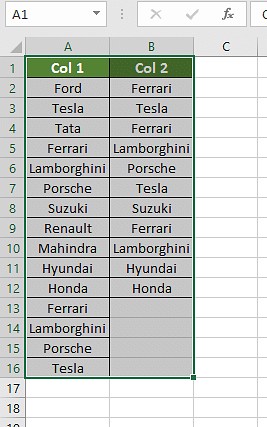In data analysis, comparing two columns in Excel is a fundamental task. Whether you’re reconciling datasets, identifying discrepancies, or simply ensuring data consistency, knowing how to effectively compare columns is crucial. Manually sifting through rows of data can be time-consuming and prone to errors. Fortunately, Excel provides a variety of built-in features and formulas to streamline this process and give you results in moments.
This article will delve into several methods for comparing two columns in Excel, catering to different scenarios and levels of complexity. From simple conditional formatting to more advanced formulas like VLOOKUP and EXACT, you’ll learn techniques to quickly highlight matches, identify unique entries, and gain valuable insights from your data.
Understanding Column Comparison in Excel
At its core, comparing columns in Excel involves evaluating the data in one column against another to find similarities or differences. This might mean checking if values in one column exist in another, identifying identical entries in both, or pinpointing unique values that appear in only one column. The goal is to automate the comparison process, saving you time and improving accuracy in your data analysis workflows.
Excel offers multiple tools to achieve this, each with its strengths and ideal use cases. Let’s explore the most effective methods.
Method 1: Conditional Formatting for Visual Comparison
Conditional formatting is a user-friendly feature in Excel that allows you to apply formatting rules to cells based on their values. This is a visually intuitive way to compare two columns and highlight matches or unique values.
Step-by-Step Guide to Conditional Formatting:
-
Select the Columns: Begin by selecting the two columns you want to compare. You can click and drag to select the entire columns or specific ranges within them.
-
Access Conditional Formatting: Navigate to the “Home” tab on the Excel ribbon. In the “Styles” group, click on “Conditional Formatting.”
-
Highlight Duplicate or Unique Values: From the “Conditional Formatting” dropdown, hover over “Highlight Cells Rules” and choose either “Duplicate Values…” or “Unique Values…” depending on what you want to identify.
Highlighting Duplicate Values
Selecting “Duplicate Values…” will open a dialog box where you can customize the formatting for duplicate entries. You can choose from predefined styles (like light red fill with dark red text) or create a custom format.
Excel will then highlight all values that appear in both selected columns based on your chosen format.
Highlighting Unique Values
Alternatively, selecting “Unique Values…” will highlight entries that are unique within the selected columns – meaning they appear only once across both columns.
This method is excellent for a quick visual scan to identify commonalities or differences between your columns.
Method 2: The Equals Operator (=) for Direct Cell Comparison
The equals operator is a basic yet powerful tool for comparing cells directly within Excel formulas. You can use it to check if the value of a cell in one column is the same as the value in the corresponding row of another column.
Steps to Use the Equals Operator:
-
Create a Result Column: Insert a new column next to the columns you are comparing. This column will display the results of your comparison.
-
Enter the Formula: In the first cell of your new result column (e.g., column C, if you are comparing columns A and B), enter the formula
=A2=B2(assuming your data starts from row 2). -
Apply the Formula: Drag the fill handle (the small square at the bottom-right corner of the selected cell) down to apply the formula to all rows in your dataset.
Excel will return “TRUE” if the values in the compared cells are identical and “FALSE” if they are different.
Enhancing with the IF Function
For more descriptive results than “TRUE” and “FALSE”, you can combine the equals operator with the IF function. This allows you to display custom messages based on whether a match is found.
For example, the formula =IF(A2=B2, "Match", "Mismatch") will display “Match” if the cells are identical and “Mismatch” otherwise.
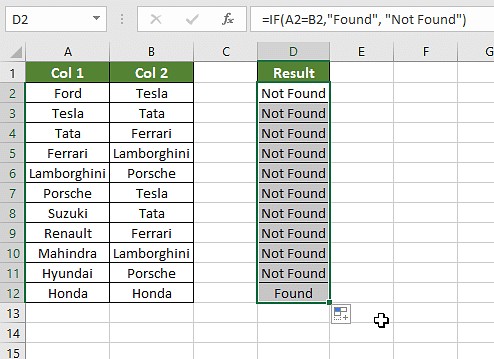{width=494 height=359}
*Alt text: Excel formula bar showing the formula "=IF(A2=B2, "Match", "Mismatch")" entered in cell C2 to compare cell A2 and cell B2 and display custom text results.*
This method is straightforward and effective for row-by-row comparisons when you need clear textual output.Method 3: VLOOKUP for Finding Matches and Differences Based on a Lookup Value
The VLOOKUP function is primarily used to find a value in a table or range by row. However, it can also be cleverly used to compare two columns, especially when you want to check if values from one column exist in another.
Using VLOOKUP for Column Comparison:
-
Create a Result Column: Similar to the equals operator method, insert a new column for your comparison results.
-
Enter the VLOOKUP Formula: In the first cell of your result column, enter the
VLOOKUPformula. The basic syntax is:=VLOOKUP(lookup_value, table_array, col_index_num, [range_lookup])To compare column A against column B, and check if values in column A are present in column B, the formula in cell C2 would be:
=VLOOKUP(A2, B:B, 1, FALSE)lookup_value: This is the value you want to search for. In our case, it’sA2, the first value in column A.table_array: This is the range where you want to search for thelookup_value. Here, we useB:B, representing the entire column B.col_index_num: This specifies which column in thetable_arrayto return a value from if a match is found. Since we are using only column B as thetable_array, we use1.[range_lookup]: Setting this toFALSEensures an exact match is required.
-
Apply the Formula: Drag the fill handle down to apply the formula to the rest of the rows.
If
VLOOKUPfinds a match (i.e., a value from column A is found in column B), it will return the matching value from column B. If no match is found, it returns the#N/Aerror.
Handling Errors with IFERROR
To replace the #N/A errors with more user-friendly text, use the IFERROR function. Wrap the VLOOKUP formula within IFERROR. For example:
=IFERROR(VLOOKUP(A2, B:B, 1, FALSE), "Not Found in Column B")
This formula will display “Not Found in Column B” instead of #N/A when a value from column A is not found in column B.
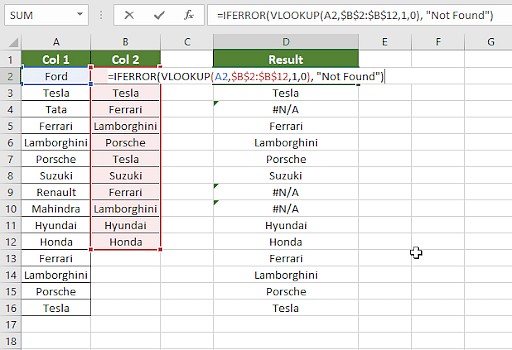{width=512 height=350}
*Alt text: Excel formula bar showing the formula "=IFERROR(VLOOKUP(A2, B:B, 1, FALSE), "Not Found in Column B")" in cell C2, which wraps the VLOOKUP formula in an IFERROR function to display a custom message instead of "#N/A" errors.*
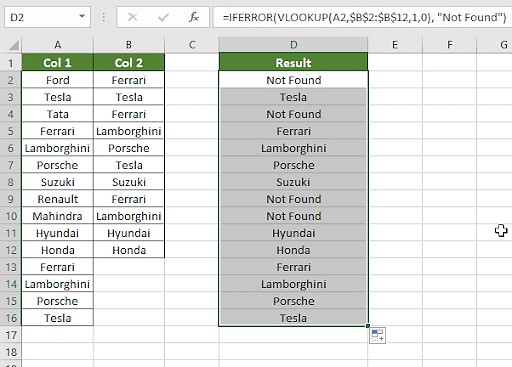{width=512 height=367}
*Alt text: Excel spreadsheet showing column C with IFERROR and VLOOKUP results, displaying values from column B for matches, and "Not Found in Column B" for values from column A not found in column B, replacing the error messages with descriptive text.*Handling Partial Matches with Wildcards in VLOOKUP
In some cases, you might need to compare columns where exact matches are not always available. For instance, one column might have “Ford India” while the other has “Ford”. VLOOKUP with wildcards can help in these situations.
By using the wildcard character * within your lookup_value, you can find partial matches. For example, to check if a value from column A starts with a value in column B, you can modify the formula:
=VLOOKUP(A2&"*", B:B, 1, FALSE)
Note that wildcard matching can be less precise and should be used cautiously depending on your data.
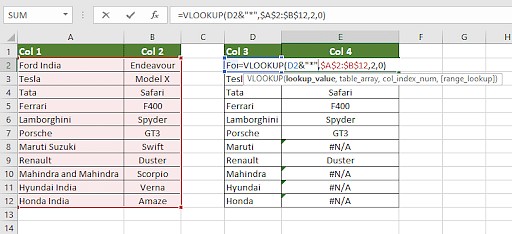{width=512 height=234}
*Alt text: Excel formula bar showing the formula "=VLOOKUP(A2&"*", B:B, 1, FALSE)" in cell C2, which includes a wildcard character "*" in the lookup value to find partial matches.*
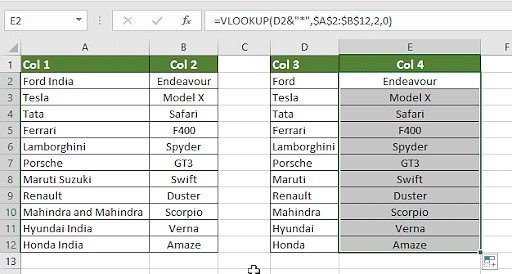{width=512 height=274}
*Alt text: Excel spreadsheet showing column C with wildcard VLOOKUP results, demonstrating matches even when column A values are partial matches to column B values, due to the wildcard implementation.*VLOOKUP is particularly useful when you need to not only compare but also retrieve related information if a match is found.
Method 4: The IF Formula for Conditional Outcomes
As briefly introduced with the equals operator, the IF formula is incredibly versatile for column comparison. It allows you to define specific outcomes based on whether a comparison is true or false.
Comparing Columns with the IF Formula:
The basic structure of the IF formula is:
=IF(logical_test, value_if_true, value_if_false)
For comparing two columns, the logical_test will often involve comparing corresponding cells.
Example: To display “Same” if car brands in column A and column B match, and “Different” if they don’t, use the formula:
=IF(A2=B2, "Same car brands", "Different car brands")
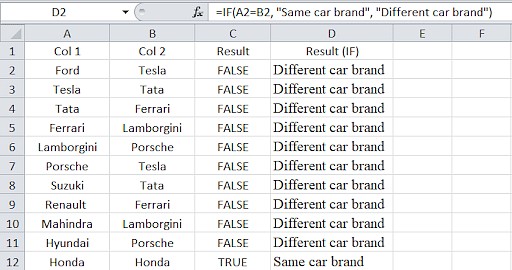{width=512 height=270}
*Alt text: Excel spreadsheet showing column D with results from the IF formula "=IF(A2=B2, "Same car brands", "Different car brands")", displaying "Same car brands" when values in column A and B match, and "Different car brands" when they don't.*This provides clear and customizable text-based results, making it easy to interpret the comparison outcomes.
Method 5: The EXACT Formula for Case-Sensitive Comparisons
All previous methods, by default, perform case-insensitive comparisons (e.g., “Apple” is considered the same as “apple”). If you need a case-sensitive comparison, the EXACT formula is the perfect tool.
Using the EXACT Formula:
The syntax for the EXACT formula is simple:
=EXACT(text1, text2)
It returns TRUE if text1 and text2 are exactly the same, including case, and FALSE otherwise.
Example: To compare column A and column B with case sensitivity, enter the formula in a result column:
=EXACT(A2, B2)
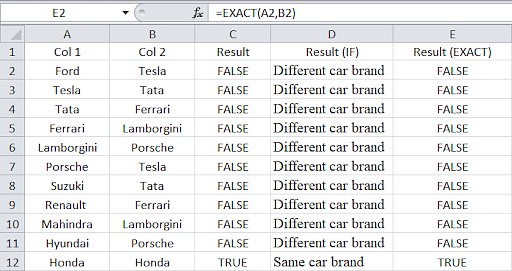{width=512 height=271}
*Alt text: Excel spreadsheet showing column C with results from the EXACT formula "=EXACT(A2, B2)", displaying "TRUE" when values in column A and B are exactly the same (including case), and "FALSE" when they are not or differ in case.*As the example shows, “Honda” and “HONDA” will be considered different by the EXACT formula, highlighting its case-sensitive nature.
Choosing the Right Method for Your Scenario
The best method for comparing two columns in Excel depends on your specific needs and the nature of your data. Here’s a guide to help you choose:
Scenario 1: Row-by-Row Comparison for Matches and Mismatches
For simple row-by-row comparisons to identify matches or mismatches, the Equals Operator and IF Formula are ideal.
- Equals Operator (
=): Quick and easy for basic TRUE/FALSE results. - IF Formula: Offers customizable text outputs like “Match” or “No Match,” and can be extended for more complex conditions.
Case-Sensitive Row-by-Row Comparison:
-
EXACT Formula: Use this for case-sensitive comparisons to ensure values are identical in every aspect.
Scenario 2: Comparing Multiple Columns for Row Matches
When you need to compare more than two columns in a row to find matches across all or some columns, you can combine formulas:
-
ANDwithinIF: For checking if all columns have matching values in a row.
=IF(AND(A2=B2, A2=C2), "Complete match", " ") -
COUNTIFwithinIF: To check if a specific number of columns match in a row.
=IF(COUNTIF($A2:$E2, $A2)=4, "Complete match", " ")(Here, 4 is the number of columns you want to match) -
ORwithinIF: To find rows where any two or more columns match.
=IF(OR(A2=B2, B2=C2, A2=C2), "Match", "") -
Combined
COUNTIFandIF: For more complex matching criteria, like identifying unique rows or rows with at least two matching cells.
=IF(COUNTIF(B2:D2,A2)+COUNTIF(C2:D2,B2)+(C2=D2)=0,"Unique","Match")
Scenario 3: Finding Unique Values (Differences) Between Two Columns
To identify values present in one column but not in another, or vice-versa:
-
COUNTIFwith Column Range: Check if a value from column A exists in column B.
=IF(COUNTIF($B:$B, $A2)=0, "Not present in B", "") -
MATCHwithISERROR: Another way to check for the absence of values.
=IF(ISERROR(MATCH($A2,$B$2:$B$10,0)),"No present in B","") -
Combined
COUNTIFfor Matches and Differences: Get both “Present” and “Not Present” results in one formula.
=IF(COUNTIF($B:$B, $A2)=0, "No Present in B", "Present in B")
Scenario 4: Comparing Two Lists and Extracting Matching Data
When comparing two lists and you need to retrieve matching data from one list based on matches in another:
-
VLOOKUP: Excellent for finding matches and pulling corresponding data.
=VLOOKUP(D2, $A$2:$B$6, 2, FALSE)(Looks up value in D2 in range A2:A6 and returns value from the 2nd column of the range if found). -
INDEX MATCH: A more flexible alternative toVLOOKUP, especially for complex lookups.
=INDEX($B$2:$B$6, MATCH($D2, $A$2:$A$6, 0))(Finds the position of D2 in A2:A6 and returns the value at that position from B2:B6). -
XLOOKUP: A modern and powerful lookup function, replacing bothVLOOKUPandINDEX MATCHin newer Excel versions.
=XLOOKUP(D2, $A$2:$A$6, $B$2:$B$6)(Looks up D2 in A2:A6 and returns the corresponding value from B2:B6).
Scenario 5: Highlighting Row Matches and Differences Visually
For visually highlighting entire rows based on column comparisons:
-
Conditional Formatting with Formulas: Use formulas within conditional formatting to highlight rows where columns match or differ.
- Highlight rows where columns A, B, and C match:
=AND($A2=$B2, $A2=$C2)or=COUNTIF($A2:$C2, $A2)=3(applied to the entire row range).
- Highlight rows where columns A, B, and C match:
-
“Go To Special” Feature for Row Differences: Quickly select and highlight cells that are different within rows.
- Select your data range.
- Go to “Home” tab > “Find & Select” > “Go To Special.”
- Choose “Row Differences” and click “OK.”
- Apply fill color to highlighted cells.
Frequently Asked Questions (FAQs)
1. What is the quickest way to compare two columns in Excel?
The “Go To Special” > “Row Differences” feature is a very quick way to visually identify differences in rows across two or more columns. For highlighting duplicates or uniques, conditional formatting is also very fast.
2. Can I use INDEX-MATCH to compare two columns?
Yes, INDEX-MATCH is a powerful method for comparing columns, particularly for retrieving matching data between lists. It offers more flexibility than VLOOKUP in many scenarios.
3. How do I compare multiple columns at once in Excel?
You can use conditional formatting with “Duplicate Values” or “Unique Values” to highlight matches or uniques across multiple selected columns. For formula-based comparisons across multiple columns, use combinations of IF, AND, OR, and COUNTIF as shown in Scenario 2.
4. How do I compare two lists for matches in Excel?
Use VLOOKUP, INDEX-MATCH, or XLOOKUP to compare two lists and find matches, especially when you need to retrieve related data from the matching entries. The COUNTIF function is also useful for simply counting matches.
5. How can I highlight duplicate values when comparing two columns in Excel?
- Select the two columns.
- Go to “Home” > “Conditional Formatting” > “Highlight Cells Rules” > “Duplicate Values.”
- Choose your desired formatting style and click “OK.”
This will highlight all values that appear in both selected columns.
Next Steps in Data Analysis with Excel
Mastering column comparison is a foundational skill in Excel-based data analysis. To further enhance your data analysis capabilities, consider exploring Pivot Tables and Pivot Charts. These powerful tools allow you to summarize, analyze, and visualize large datasets interactively, creating dynamic dashboards and reports directly in Excel.
Continue your journey to become a proficient data analyst by delving deeper into Excel’s advanced features and data analysis techniques. The ability to effectively compare and analyze data is a highly sought-after skill in today’s data-driven world.
